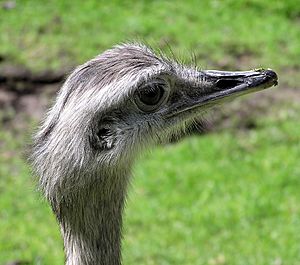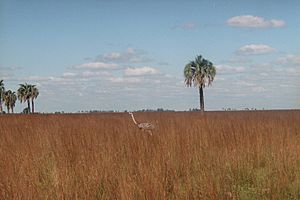Greater rhea facts for kids
Quick facts for kids Greater rhea |
|
|---|---|
 |
|
| Conservation status | |
| Scientific classification | |
| Kingdom: | |
| Class: | |
| Subclass: | |
| Infraclass: | |
| Order: |
Struthioniformes
|
| Family: |
Rheidae
|
| Genus: | |
| Binomial name | |
| Rhea americana (Linnaeus, 1758)
|
|
The greater rhea (Rhea americana) is a large flightless bird that lives in South America. People also call it the grey rhea, common rhea, or American rhea. This amazing bird was first described by Carl Linnaeus in 1758. You can find it in countries like Argentina, Bolivia, Brazil, Paraguay, and Uruguay.
The greater rhea gets its scientific name from Rhea, a goddess in Greek mythology. The word "americana" comes from Latin, meaning "from America."
These birds are quite big! They can be about 3–5 feet (0.91–1.52 m) long. Their wingspan can reach 5 feet (1.5 m). Greater rheas usually weigh between 50–55 pounds (23–25 kg). This makes them the largest birds in South America.
Contents
What Does a Greater Rhea Look Like?

Adult greater rheas usually weigh about 20–27 kg (44–60 lb). They measure around 129 cm (51 in) from their beak to their tail. They stand about 1.50 m (4.9 ft) tall. Male rheas are generally larger than females. Very large males can weigh up to 40 kilograms (88 lb) and stand almost 1.83 m (6.0 ft) tall. They can also be over 150 cm (59 in) long, but this is not common.
Greater rheas have long, strong legs with three toes. Their wings are quite long, even though they cannot fly. They use their wings to help them balance when they run fast or make sharp turns.
Their feathers look fluffy and a bit messy. The feathers are usually gray or brown, but their exact color can vary a lot from one bird to another. Males are often darker than females. Sometimes, you can even see rheas with white feathers and blue eyes (called leucistic) or completely white feathers and pink eyes (called albino). Baby rheas are grey with dark stripes running down their bodies.
Where Do Greater Rheas Live?
The greater rhea lives only in Argentina, Bolivia, Brazil, Paraguay, and Uruguay. These birds prefer to live in grasslands with tall grasses. They also live in savannas, scrub forests, and even some desert areas. They like places that have at least some tall plants. You won't find them in the very wet tropical forests along the coast of Brazil. During the breeding season, which is spring and summer, they like to stay close to water.
Interestingly, a small group of greater rheas has started living in Germany. These rheas are now protected by law in Germany, just like birds that are native to the country.
What Do Greater Rheas Eat?
Greater rheas mostly eat plants. They love broad-leaved plants, seeds, and fruits when they are in season. They can even eat tough or spiny plants like tubers and thistles. To help them digest tough plant matter, rheas swallow small pebbles. These pebbles act like grinders in their stomach. They are also attracted to shiny things and sometimes accidentally swallow metal or glossy objects.
Rheas can be very helpful to farmers. In fields where farmers grow crops they don't like to eat, such as cereals, rheas will eat many invertebrates. Their diet includes locusts, grasshoppers, cockroaches, and other pest insects. They even eat small vertebrates like rodents, snakes, lizards, and small birds. Sometimes, rheas will gather around dead animals to eat flies. They might also eat dead or dying fish during the dry season, but they don't eat many vertebrates in general.
Who Are the Predators of Greater Rheas?
Adult greater rheas have only a few natural predators. These include the cougar and the Jaguar. Feral dogs are known to hunt and kill younger rheas. The Southern Caracara might also prey on baby rheas. Armadillos sometimes eat greater rhea eggs. Nests have been found where armadillos, like the Six-banded Armadillo or Big Hairy Armadillo, have dug under them and broken the eggs.
Greater Rhea Life Cycle and Reproduction
Greater rheas breed during the warmer months, usually from August to January. The exact timing depends on the weather. Female rheas move around during this season. They mate with a male and lay their eggs in his nest. Then, they leave to mate with another male. Male rheas stay in one place. They take care of the nests, incubate the eggs, and look after the baby rheas all by themselves.
Because several females lay eggs in the same nest, a single nest can hold as many as 80 eggs! These eggs might come from up to a dozen different females. Each female usually lays about 5 to 10 eggs. However, the average nest has about 26 eggs from 7 different females.
Rhea eggs are about 130 mm × 90 mm (5.1 in × 3.5 in) in size. They weigh around 600 g (21 oz). This means they are less than half the size of an ostrich egg. When fresh, their shells are greenish-yellow. But they quickly fade to a dull cream color when exposed to light. The nest itself is a simple, shallow dip in the ground, hidden away. Males will pull sticks, grass, and leaves around the nest to make it look like a clear area.
The eggs take about 29 to 43 days to hatch. All the eggs in a nest hatch within 36 hours of each other. This is amazing because the eggs might have been laid up to two weeks apart! It seems that when the first chicks are ready to hatch, they make a special sound, even from inside the egg. This sound helps all the other chicks know it's time to hatch together. Greater rheas are half-grown about three months after they hatch. They become old enough to have their own babies when they are about 14 months old.
Conservation Status
The Greater Rhea is considered a Near Threatened species. This means that while it's not in immediate danger, its population could become threatened in the future. This status is given by the IUCN.
Rhea Farming
Greater rheas are farmed in North America and Europe. This is similar to how Emus and Ostriches are farmed. The main things people get from rheas are meat and eggs. But rhea oil is also used to make cosmetics and soaps. And rhea leather is sold in large amounts. Male greater rheas can be very protective of their territory during the breeding season. Baby chicks often have a hard time surviving in typical farming setups. However, if they are raised in good, open-range conditions, chicks can reach adult size by their fifth month.
Images for kids
-
A wild greater rhea in a cereal field in Mecklenburg-Vorpommern, Germany. They usually hide in such fields rather than eating the plants.
See also
 In Spanish: Ñandú común para niños
In Spanish: Ñandú común para niños









